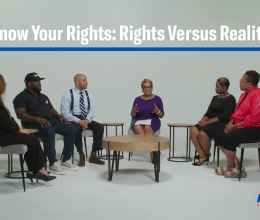Many would like to quickly move forward now that a grand jury has decided not to indict the Cleveland police officers involved in the tragic death of Tamir Rice, the 12 year old child who was shot in less than one second while playing in a park. But we cannot move past the death of Tamir. Instead, we should focus on understanding how the young boy was perceived before he was killed, how he was characterized post-mortem, and the history that allows that negative characterization to prevail today. Age of Justification Following the death of Tamir Rice, much attention was paid to his size. The Cleveland Police Patrolmen Association president said “Tamir Rice is in the wrong. He’s menacing. He’s 5-feet-7, 191 pounds. He wasn’t that little kid you’re seeing in pictures. He’s a 12-year-old in an adult body.” After the decision not to indict the officers was reached, the prosecutor commented that Tamir’s size made him appear much older for his age. The fixation on the size of black bodies dates back to America’s days of slave auctions, where size was exploited for value and profit. Adultification and attempts to justify physical attacks against black children in America is not new either. In fact, being young did not protect Black children from being lynched in America. From the late 1800s to 1950s Black boys and girls as young as 8 years of age were hanged to their deaths from trees. One such child was 14 year old Emmitt Till, killed in 1955.
Today state violence against Black children is expressed through disproportionate school suspensions, arrests, charges, adjudications, bind-overs to adult prisons, and deadly force at the hands of police for similar behaviors as their white peers.
Like many Black children robbed of their childhood, Tamir Rice was a victim of racialized adultification. One of the six men who killed Emmitt Till, said “he looked like a man.” Mike Brown, was compared to “Hulk Hogan” and Travyon Martin was also portrayed as a monster by media. Criminal Perceptions It is no accident that these children were described this way. As noted in a study, Phillip Atiba Goff, Ph.D., of the University of California, found that “Black boys are seen as older and less innocent and that they prompt a less essential conception of childhood than do their White same-age peers.” The study also found that “the Black/ape association predicted actual racial disparities in police violence toward children.” This country has a 400 year history of imposing state violence on Black children, endorsing that terror, justifying it and excusing it. Today state violence against Black children is expressed through disproportionate school suspensions, arrests, charges, adjudications, bind-overs to adult prisons, and deadly force at the hands of police for similar behaviors as their white peers. No, we cannot drive past this heartbreaking moment at a high rate of speed. In order to end this perpetual commitment to dehumanization, this country and all of its systems must do the hard work of uncovering racism, understanding it, and undoing it. Anything less is an endorsement of bigotry. Acknowledging America’s addiction to and denial of racism could be a first step in atonement and may clear a path towards reconciliation.







